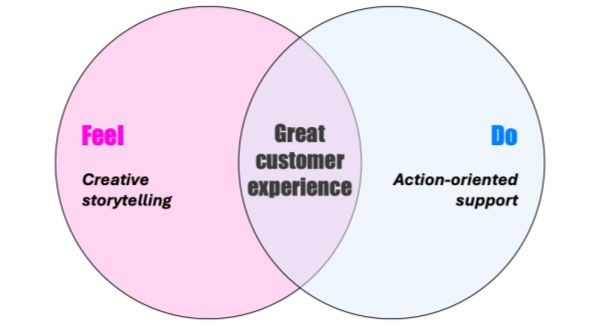28th October 2025
BlogRose Meredith, Senior UX Strategist
Something that we see daily in healthcare and more broadly are brands overplaying one side of the game. They either really understand the importance of emotional and creative storytelling but then drop the ball on the practicality of conversion…or they go the other way, focused on efficiency, through frictionless platforms and simple sales funnels, but they leave no impact for retention and stickiness.
Neither of these approaches work long-term; to be effective, and drive long-term value and advocacy, customer experiences (CX) must sit on a sliding scale between feel and do:

Understanding Feel vs. Do
- Feel is the emotive side: How you speak, the stories you choose to tell, and how to resonate with your audience.
- Do is the functional side: The simplicity of the exchange, clearly marked actions, and practical next steps.
If the feel is strong but the basics don’t work, people may struggle to commit. If the do is seamless but there’s no emotional pull, the brand risks being forgettable.
Why balance matters
Customers are hounded with advertising every single day.
- If you lean too much into feel, you risk admiration without action. Not for profit charities are a good example: crafting some of the most powerful, emotional storytelling in the world, but donations often are paired with extensive forms, no Apple Pay, no one-click option, meaning many turn away at the last step.
- If you lean too much into do, you risk becoming a commodity. Just Eat is an example where you can be efficient, simple, and focused but lack customer connections – meaning that users often switch between them and their competitors depending on who has the best deals.
The brands that win are the ones that know how to work the scale and drive balance.
The sliding scale across the journey
So, what is the scale, and when do you switch between feel and do?
Using a traditional conversion funnel:
- Awareness: lead with feel, people must care before they click.
- Consideration: blend feel, and do, keep it relevant while building credibility
- Conversion: this is where do takes over. Make it clear, simple, fast.
- Retention/advocacy: back to feel, remind them why they chose you – and give them a reason to stick around.
How we apply this at Havas Lynx CX
CX, UX and technology specialists within our experience team here at Havas Lynx alongside our creative agency partners and brand stewards champion their own area of the customer experience. The job is to find the sweet spot between the feel and do for our internal and external stakeholders based on the strategic business objective at hand.
Case Study
The reality of reversing obesity
This project aimed to support our target audience in navigating the complex, crowded space of weight-loss aids. By streamlining access to high-value, credible information, we could ultimately support more informed choices around living with obesity; and potential treatment options if deemed appropriate.
We identified three key challenges:
- The market was saturated with misinformation, especially on social media
- Influential voices were largely silent, or worse passing judgement rather than support
- Available information focused on weight loss but not health
One thing was clear: people living with obesity wanted to hear from others who shared their experience. We didn’t need to insert ourselves into the narrative, we needed to facilitate it. To create a safe space where people could share openly, without fear of judgment or misinformation.
This approach aligned with our client’s positioning: their product is a medical aid, not a consumer good.
So, when we set out to create something meaningful for people living with obesity, we knew it couldn’t just be about weight loss. It had to reflect the reality the challenges, hopes, and long-term goals for health and well-being that define this journey.
That meant starting with feel. We had to listen and truly understand the lived experience of managing obesity, not through an external lens, but through the voices of the community, their stories, and the things they care about most.
That’s why we created My Metabolic Circle; a personalised newsletter service designed to reflect real stories and provide support that feels relevant. It connects people with shared experiences and delivers advice tailored to the goals people living with obesity set for themselves.
But while feel guided our intention, do demanded more.
We didn’t just want people to observe our growing community. We wanted them to be part of it and contribute; to foster that advocacy, higher purpose and stickiness. To do that, we made these community members central to the story. Anybody had the chance to be featured. This wasn’t about showcasing “perfect” stories, it was about showing the good, bad and ugly truth that sits alongside weight loss; and communicating with authenticity. We added clear calls to action and made it easy for people to contribute; forms were short, we minimised mandatory fields down to what was truly mandatory, and we didn’t try and pry for unnecessary data.


We also built in AI tools to help transform those contributions into publishable stories; making the process smoother for editors and pushing their focus back to empowering the community, while ensuring that new stories could be published in a timely manner, rather than 6 months down the line.
Before we launched, we wanted to test our workings, but with the red tape of pharma, that’s not always simple! So, we validated using our proprietary synthetic testing approach allowing us to refine our digital products throughout development:
“I really like the idea of submitting a question that could be featured in a weekly digest. It feels safer than posting on a public forum and is a great way to get expert input without feeling exposed. It also helps manage the community by curating the most relevant topics. But watch out, the “real stories” need to stay real – if they start to feel too polished or like marketing material, I’d lose trust quickly, maintaining authenticity will be critical.”
– Some sage advice from our synthetic audience member during our development process
Once we found the balance, ensuring everything worked together to ensure empathy meets action, we created something that not only resonated but also moves people forward. With that, we could ultimately, measure success through both feel and do.
On the feel side, we looked at qualitative indicators: how people spoke about the community, the tone of their contributions, and the sense of trust and support they expressed. As well as how many people opted-in and stayed in the scheme.
On the do side, we tracked metrics that helped us identify friction points: That meant tracking how easy the experience was to engage with. We looked at how many people found the calls to action, how many started and completed the contribution form, and how many returned to share more.
What we should ask ourselves before any launch
With that, three simple questions to ask yourselves when developing artefacts for any campaign or unmet need:
- Are we over-indexing on “feel” and leaving people stranded when they try to act?
- Are we so focused on efficiency that we’ve drained the humanity out of the brand?
- Do we really know, step by step, when to lean emotionally and when to lean functional?
- Do we understand feel and do in the context of our business or project and what these terms really mean for us? What is measurable?
In short
CX isn’t about choosing between art and science. It’s about weaving them together. The feel gets people to believe in you. The do makes it easy for them to act on that belief. If you can move smoothly along that sliding scale, you create the kind of experiences people come back for.
If you fancy a natter on this topic, or anything else CX, give us a shout at cx@havaslynx.com. Or, have a watch our webinar for more!
